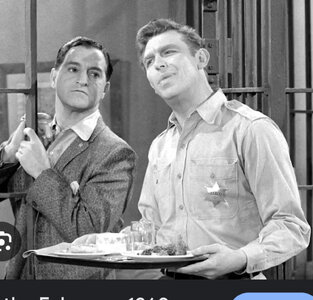Navigation
Install the app
How to install the app on iOS
Follow along with the video below to see how to install our site as a web app on your home screen.
Note: This feature may not be available in some browsers.
More options
You are using an out of date browser. It may not display this or other websites correctly.
You should upgrade or use an alternative browser.
You should upgrade or use an alternative browser.
This Date in History | Six Regulators Hanged
- Thread starter donbosco
- Start date
- Replies: 766
- Views: 15K
- Off-Topic
- Messages
- 1,102
The Miracle on Ice
During the 1980 Winter Olympics, against the backdrop of the Cold War, the U.S. ice hockey team defeated the favoured Soviet team in one of the greatest upsets in the history of the Olympic Games.
The "Miracle on Ice" was an ice hockey game during the 1980 Winter Olympics in Lake Placid, New York. It was played between the hosting United States and the Soviet Union on February 22, 1980, during the medal round of the men's ice hockey tournament. Although the Soviet Union was a four-time defending gold medalist and heavily favored, the United States achieved an upset victory, winning 4–3.
The Soviet Union had won the gold medal in five of the six previous Winter Olympic Games, and they were the favorites to win once more in Lake Placid. The Soviet team consisted of professional players with significant experience in international play.[1] By contrast, the United States team, led by head coach Herb Brooks, was composed mostly of amateur players, with only four players with minimal minor-league experience. In addition, the United States had the youngest team in the tournament and in U.S. national team history.
In the group stage, both the Soviet and American teams were undefeated; the U.S. achieved several surprising results, including a 2–2 draw against Sweden,[2] and a 7–3 upset victory over second-place favorite Czechoslovakia.[3][4]
For the first game in the medal round, the Americans played the Soviets. Finishing the first period tied at 2–2, and the Soviets leading 3–2 following the second, the U.S. team scored two more goals to take their first lead midway in the third and final period, then held out to win by a score of 4–3.[5][6] Two days later, the U.S. secured the gold medal by defeating Finland 4–2 in their final game, while the Soviet Union claimed the bronze medal with a dominant 9–2 victory over Sweden.[7][8]
The victory became one of the most iconic moments of the Games and in U.S. sports. Equally well-known was the television call of the final seconds of the game by Al Michaels for ABC, in which he declared: "Do you believe in miracles? Yes!" In 1999, Sports Illustrated named the "Miracle on Ice" the top sports moment of the 20th century.[9] As part of its centennial celebration in 2008, the International Ice Hockey Federation (IIHF) named the "Miracle on Ice" as the top international ice hockey story of the past 100 years.[10]

During the 1980 Winter Olympics, against the backdrop of the Cold War, the U.S. ice hockey team defeated the favoured Soviet team in one of the greatest upsets in the history of the Olympic Games.
The "Miracle on Ice" was an ice hockey game during the 1980 Winter Olympics in Lake Placid, New York. It was played between the hosting United States and the Soviet Union on February 22, 1980, during the medal round of the men's ice hockey tournament. Although the Soviet Union was a four-time defending gold medalist and heavily favored, the United States achieved an upset victory, winning 4–3.
The Soviet Union had won the gold medal in five of the six previous Winter Olympic Games, and they were the favorites to win once more in Lake Placid. The Soviet team consisted of professional players with significant experience in international play.[1] By contrast, the United States team, led by head coach Herb Brooks, was composed mostly of amateur players, with only four players with minimal minor-league experience. In addition, the United States had the youngest team in the tournament and in U.S. national team history.
In the group stage, both the Soviet and American teams were undefeated; the U.S. achieved several surprising results, including a 2–2 draw against Sweden,[2] and a 7–3 upset victory over second-place favorite Czechoslovakia.[3][4]
For the first game in the medal round, the Americans played the Soviets. Finishing the first period tied at 2–2, and the Soviets leading 3–2 following the second, the U.S. team scored two more goals to take their first lead midway in the third and final period, then held out to win by a score of 4–3.[5][6] Two days later, the U.S. secured the gold medal by defeating Finland 4–2 in their final game, while the Soviet Union claimed the bronze medal with a dominant 9–2 victory over Sweden.[7][8]
The victory became one of the most iconic moments of the Games and in U.S. sports. Equally well-known was the television call of the final seconds of the game by Al Michaels for ABC, in which he declared: "Do you believe in miracles? Yes!" In 1999, Sports Illustrated named the "Miracle on Ice" the top sports moment of the 20th century.[9] As part of its centennial celebration in 2008, the International Ice Hockey Federation (IIHF) named the "Miracle on Ice" as the top international ice hockey story of the past 100 years.[10]

donbosco
Inconceivable Member
- Messages
- 3,372
#OTD 1945 b. William Oliver Swofford in N.Wilkesboro. A Morehead Scholar @UNC, his college band unsuccessful, he recorded ‘Good Morning Starshine’ from the musical ‘Hair’ as OLIVER & hit #3 on the Billboard Easy Listening Charts in ‘69. Two months later, ‘Jean’ hit #2. He had modest success in the ‘70s, left music, had a good career in sales, & passed away in 2000. Brother John was Commissioner of the Atlantic Coast Conference & Quarterbacked @UNC. Another brother played football @dook.
Oliver, North Wilkesboro Native, a Sixties Pop Sensation
Oliver, North Wilkesboro Native, a Sixties Pop Sensation
- Messages
- 1,102
#OTD 1945 b. William Oliver Swofford in N.Wilkesboro. A Morehead Scholar @UNC, his college band unsuccessful, he recorded ‘Good Morning Starshine’ from the musical ‘Hair’ as OLIVER & hit #3 on the Billboard Easy Listening Charts in ‘69. Two months later, ‘Jean’ hit #2. He had modest success in the ‘70s, left music, had a good career in sales, & passed away in 2000. Brother John was Commissioner of the Atlantic Coast Conference & Quarterbacked @UNC. Another brother played football @dook.
Oliver, North Wilkesboro Native, a Sixties Pop Sensation
You forgot to mention brother John's success in behind the scenes maneuvers as the cause of all of ncsu athletic woes. Stil to this day.
- Messages
- 1,223
#OTD 1945 b. William Oliver Swofford in N.Wilkesboro. A Morehead Scholar @UNC, his college band unsuccessful, he recorded ‘Good Morning Starshine’ from the musical ‘Hair’ as OLIVER & hit #3 on the Billboard Easy Listening Charts in ‘69. Two months later, ‘Jean’ hit #2. He had modest success in the ‘70s, left music, had a good career in sales, & passed away in 2000. Brother John was Commissioner of the Atlantic Coast Conference & Quarterbacked @UNC. Another brother played football @dook.
Oliver, North Wilkesboro Native, a Sixties Pop Sensation
Oliver (Swofford) appeared on the Ed Sullivan show. After Oliver had sung his song(s), Ed Sullivan walked on stage to stand next to Oliver and motioned out into the audience and a camera zoomed in on Oliver's parents and John Swofford. Ed Sullivan introduced them and they got a round of applause. Then Ed Sullivan announced that John Swofford held the UNC record for the most touchdown passes in a single game. A bigger round of applause ensued. My older brother told me that in a home game against the Air Force Academy, starting QB (maybe Gayle Bomar) had gotten injured early on and John Swofford played most of the game. The Air Force Academy was notorious in those days for having a poor defense and John Swofford just tore them apart with his passing.
- Messages
- 2,441
I saw that Ed Sullivan showOliver (Swofford) appeared on the Ed Sullivan show. After Oliver had sung his song(s), Ed Sullivan walked on stage to stand next to Oliver and motioned out into the audience and a camera zoomed in on Oliver's parents and John Swofford. Ed Sullivan introduced them and they got a round of applause. Then Ed Sullivan announced that John Swofford held the UNC record for the most touchdown passes in a single game. A bigger round of applause ensued. My older brother told me that in a home game against the Air Force Academy, starting QB (maybe Gayle Bomar) had gotten injured early on and John Swofford played most of the game. The Air Force Academy was notorious in those days for having a poor defense and John Swofford just tore them apart with his passing.
- Messages
- 1,102
One of my neighbors growing up was right there. Fought with these guys. Had a photo album to prove it. Could have joined them to raise flag but basically said:
Fuck that! I"m tired as hell. Ain't going to climb no hill. Going to sit back and smoke a cigarette.
1945 Six U.S. servicemen raised the American flag over Mount Suribachi on the island of Iwo Jima during World War I
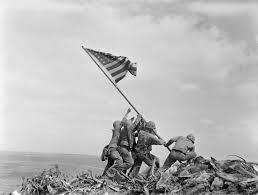
Iwo Jima, island that is part of the Volcano Islands archipelago, far southern Japan. The island has been widely known as Iwo Jima, its conventional name, since World War II (1939–45). However, Japan officially changed the name to its Japanese form, Iō-tō (Iō Island), in 2007.
Iwo Jima lies in the western Pacific at a point about 760 miles (1,220 km) south-southeast of Tokyo. The island is irregular in shape; it is about 5 miles (8 km) long and ranges from 800 yards to 2.5 miles (730 metres to 4 km) wide. It has an area of about 8 square miles (20 square km). Administratively, it is part of Tokyo metropolis.
Iwo Jima was under Japanese administration until early in 1945, when it became the scene of a fierce battle between Japanese and invading U.S. troops during the last phases of World War II. The island was strategically important because, if captured, it could serve as a base for U.S. fighter planes to accompany U.S. heavy bombers flying to Japan from bases on Saipan, an island 700 miles (1,100 km) farther south that U.S. troops had taken in 1944. Two U.S. Marine divisions landed on Iwo Jima February 19–21, 1945, and were followed by a third later in the month. The island’s Japanese defenders had entrenched themselves so effectively in caves that weeks of preliminary naval and air bombardment failed to appreciably weaken their ability to offer tenacious resistance to the Marines’ amphibious landing. The struggle for possession of the island continued for almost a month before it was officially pronounced captured by the United States. The hardest struggles were for the occupation of a height that U.S. forces labeled Meatgrinder Hill, in the north, and Mount Suribachi, an extinct volcano in the south.
The raising of the American flag over Mount Suribachi (February 23), which was photographed by Joe Rosenthal of the Associated Press, resulted in one of the best-known photographic images of the Pacific war. This picture was widely reprinted, and statues, paintings, and a U.S. postage stamp were based on it. (The photograph actually depicts the second flag raising over Mount Suribachi, after a first flag raised an hour or two earlier had proved too small to be visible to other U.S. troops on the island.)
About 21,000 Japanese troops were killed and some 1,000 captured in the main battle and subsequent operations. U.S. casualties totaled about 28,000, including about 6,800 killed. Iwo Jima and the other Volcano Islands were administered by the United States from 1945 until they were returned to Japan in 1968.
Fuck that! I"m tired as hell. Ain't going to climb no hill. Going to sit back and smoke a cigarette.
1945 Six U.S. servicemen raised the American flag over Mount Suribachi on the island of Iwo Jima during World War I

Iwo Jima, island that is part of the Volcano Islands archipelago, far southern Japan. The island has been widely known as Iwo Jima, its conventional name, since World War II (1939–45). However, Japan officially changed the name to its Japanese form, Iō-tō (Iō Island), in 2007.
Iwo Jima lies in the western Pacific at a point about 760 miles (1,220 km) south-southeast of Tokyo. The island is irregular in shape; it is about 5 miles (8 km) long and ranges from 800 yards to 2.5 miles (730 metres to 4 km) wide. It has an area of about 8 square miles (20 square km). Administratively, it is part of Tokyo metropolis.
Iwo Jima was under Japanese administration until early in 1945, when it became the scene of a fierce battle between Japanese and invading U.S. troops during the last phases of World War II. The island was strategically important because, if captured, it could serve as a base for U.S. fighter planes to accompany U.S. heavy bombers flying to Japan from bases on Saipan, an island 700 miles (1,100 km) farther south that U.S. troops had taken in 1944. Two U.S. Marine divisions landed on Iwo Jima February 19–21, 1945, and were followed by a third later in the month. The island’s Japanese defenders had entrenched themselves so effectively in caves that weeks of preliminary naval and air bombardment failed to appreciably weaken their ability to offer tenacious resistance to the Marines’ amphibious landing. The struggle for possession of the island continued for almost a month before it was officially pronounced captured by the United States. The hardest struggles were for the occupation of a height that U.S. forces labeled Meatgrinder Hill, in the north, and Mount Suribachi, an extinct volcano in the south.
The raising of the American flag over Mount Suribachi (February 23), which was photographed by Joe Rosenthal of the Associated Press, resulted in one of the best-known photographic images of the Pacific war. This picture was widely reprinted, and statues, paintings, and a U.S. postage stamp were based on it. (The photograph actually depicts the second flag raising over Mount Suribachi, after a first flag raised an hour or two earlier had proved too small to be visible to other U.S. troops on the island.)
About 21,000 Japanese troops were killed and some 1,000 captured in the main battle and subsequent operations. U.S. casualties totaled about 28,000, including about 6,800 killed. Iwo Jima and the other Volcano Islands were administered by the United States from 1945 until they were returned to Japan in 1968.
donbosco
Inconceivable Member
- Messages
- 3,372
Buckminster Fuller Developed Geodesic Dome Design at Black Mountain, Raleigh
There used to be some domes around Chapel Hill - maybe out toward Storybook Farm and Northampton West (are those places still there?).
There used to be some domes around Chapel Hill - maybe out toward Storybook Farm and Northampton West (are those places still there?).
- Messages
- 1,102
In this day and age I am thinking this may be the most important event in the nation's history for this date and top 10 overall. Whether it holds up is too be seen. Worth reading the brief explanation if you do not know the details.
1803 In Marbury v. Madison , the U.S. Supreme Court declared an act of Congress unconstitutional, thus establishing the doctrine of judicial review.
In the weeks before Thomas Jefferson’s inauguration as president in March 1801, the lame-duck Federalist Congress created 16 new circuit judgeships (in the Judiciary Act of 1801) and an unspecified number of new judgeships (in the Organic Act), which Adams proceeded to fill with Federalists in an effort to preserve his party’s control of the judiciary and to frustrate the legislative agenda of Jefferson and his Republican (Democratic-Republican) Party. Because he was among the last of those appointments (the so-called “midnight appointments”), William Marbury, a Federalist Party leader from Maryland, did not receive his commission before Jefferson became president. Once in office, Jefferson directed his secretary of state, James Madison, to withhold the commission, and Marbury petitioned the Supreme Court to issue a writ of mandamus to compel Madison to act.
Marbury and his lawyer, former attorney general Charles Lee, argued that signing and sealing the commission completed the transaction and that delivery, in any event, constituted a mere formality. But formality or not, without the actual piece of parchment, Marbury could not enter into the duties of office. Despite Jefferson’s hostility, the court agreed to hear the case, Marbury v. Madison, in its February 1803 term.
Some scholars have questioned whether Marshall should have removed himself from the case because of his prior service as Adams’s secretary of state (1800–01). Certainly, later judicial standards would have called for recusal, but at the time only financial connections to a case led judges to step aside, as Marshall did in suits regarding Virginia lands in which he had an interest. The Republicans, always quick to criticize Marshall, did not even raise the issue of the propriety of his sitting in the case.
The issue directly presented by Marbury v. Madison can only be described as minor. By the time the court heard the case, the wisdom of Jefferson’s desire to reduce the number of justices of the peace had been confirmed (and the Judiciary Act of 1801 had been repealed); Marbury’s original term was almost half over; and most people, Federalists and Republicans alike, considered the case to be moot. But Marshall, despite the political difficulties involved, recognized that he had a perfect case with which to expound a basic principle, judicial review, which would secure the Supreme Court’s primary role in constitutional interpretation.

1803 In Marbury v. Madison , the U.S. Supreme Court declared an act of Congress unconstitutional, thus establishing the doctrine of judicial review.
In the weeks before Thomas Jefferson’s inauguration as president in March 1801, the lame-duck Federalist Congress created 16 new circuit judgeships (in the Judiciary Act of 1801) and an unspecified number of new judgeships (in the Organic Act), which Adams proceeded to fill with Federalists in an effort to preserve his party’s control of the judiciary and to frustrate the legislative agenda of Jefferson and his Republican (Democratic-Republican) Party. Because he was among the last of those appointments (the so-called “midnight appointments”), William Marbury, a Federalist Party leader from Maryland, did not receive his commission before Jefferson became president. Once in office, Jefferson directed his secretary of state, James Madison, to withhold the commission, and Marbury petitioned the Supreme Court to issue a writ of mandamus to compel Madison to act.
Marbury and his lawyer, former attorney general Charles Lee, argued that signing and sealing the commission completed the transaction and that delivery, in any event, constituted a mere formality. But formality or not, without the actual piece of parchment, Marbury could not enter into the duties of office. Despite Jefferson’s hostility, the court agreed to hear the case, Marbury v. Madison, in its February 1803 term.
Some scholars have questioned whether Marshall should have removed himself from the case because of his prior service as Adams’s secretary of state (1800–01). Certainly, later judicial standards would have called for recusal, but at the time only financial connections to a case led judges to step aside, as Marshall did in suits regarding Virginia lands in which he had an interest. The Republicans, always quick to criticize Marshall, did not even raise the issue of the propriety of his sitting in the case.
The issue directly presented by Marbury v. Madison can only be described as minor. By the time the court heard the case, the wisdom of Jefferson’s desire to reduce the number of justices of the peace had been confirmed (and the Judiciary Act of 1801 had been repealed); Marbury’s original term was almost half over; and most people, Federalists and Republicans alike, considered the case to be moot. But Marshall, despite the political difficulties involved, recognized that he had a perfect case with which to expound a basic principle, judicial review, which would secure the Supreme Court’s primary role in constitutional interpretation.

donbosco
Inconceivable Member
- Messages
- 3,372
Out by Storybrook yes. You shoukf post something on the farm. New one of the welders quite well. Went to a couple weddings there. Owner had, um, some interesting sociological/political leanings.
Never went there in all my years of living in the area. My brother lived out that way for years. I did visit friends at Northhampton West though...how that place got out there I do not know.
donbosco
Inconceivable Member
- Messages
- 3,372
When the character of Sheriff Andy Taylor first appeared in an episode of ‘The Danny Thomas Show,’ aired on February 15, 1960, he was more a bad cop than a good one and in some early episodes of his own show Griffith continued in that role - as an opportunist and slightly mean-spirited trickster. But that’s not the Andy that we love, and we know now that Griffith made a conscious move away from that representation by the second season. That’s a good thing for us all - if any of you have seen ‘Face in the Crowd’ you know the kind of malevolence that Griffith could muster up. Thankfully Sheriff Taylor stepped away from that and toward the honest, wise, and thoughtful lawman that we love.
donbosco
Inconceivable Member
- Messages
- 3,372
#OTD in 1884: BLOOD SHOWER IN CHATHAM: “On February 25, 1884, Mrs. Kit Lasater, “noted for truthfulness,” was walking near her home in the New Hope township of Chatham County when she heard what she thought was a hard rain fall. Glancing up she saw only clear sky but when she glanced down she saw what appeared to be the aftermath of a “shower of pure blood.”
None of the liquid had fallen on her but it had drenched the ground and surrounding trees for some 60 feet (some accounts say yards) in circumference from the spot where she stood. Upon hearing her story, neighbors rushed to see for themselves and, when later interviewed, confirmed the story as related by Mrs. Lasater.
Samples were collected and sent to Dr. F. P. Venable, a professor at UNC, for evaluation. By mid-April he addressed the topic to the Mitchell Scientific Society. In every test performed except one, the conclusion was the same. The samples appeared to be blood. Venable could offer no explanation beyond the results of the tests, suggesting that “the subject is quite a puzzle and offers a tempting field for the theorist blessed with a vivid imagination.”
 www.dncr.nc.gov
www.dncr.nc.gov
A month later the reprint from The Pittsboro Record, posted as first the comment, appeared in Orange County Observer. Of course I’m intrigued by the information that is recounted there that I had never before read - most specifically the reference to “the bars near her cabin” in the newspaper account. New Hope Township, where Mrs. Lasater (her first name goes unmentioned) lived is the part of Chatham most inundated by the creation of Jordan Lake in the 1970s and by my judgment one of the wilder parts, rivaled only by the flat woods on the far other end of the county.
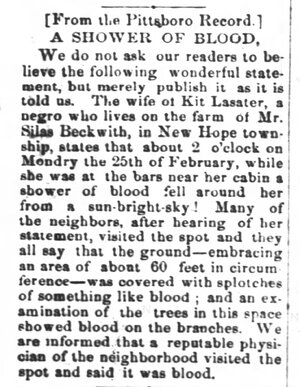
The time was just post-Reconstruction, and the governor Thomas Jarvis was a Democrat, as was always the case in those days. An ex-Confederate, he was a Redeemer (Conservative, White Supremacists who worked to thwart post-Civil War Republican and African American power) and closely tied to Zebulon Vance. Indeed, he took over the office of governor when Vance went to the U.S. Senate and later filled his seat when he died in that office. In the interim he served as ambassador to Brazil.
Of course these are just musings about the tenor of the times - a particular time long past - the kind of thing my students and I try and work out as exercises in “doing history.” I’ll add that perusing the News of Chatham during that time reveals a tumultuous and mysterious place. A news report (included) from September 12, 1884 writes of a disinterred body found petrified and another from June 13, 1883 tells of a rain of frogs covering “40 or 59 acres of land” (also posted here).
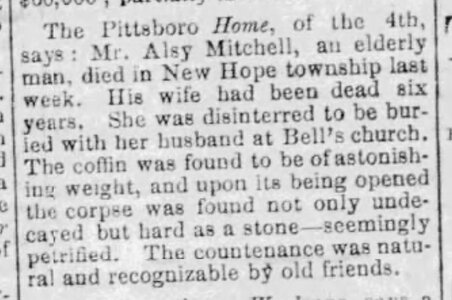
Petrified Body
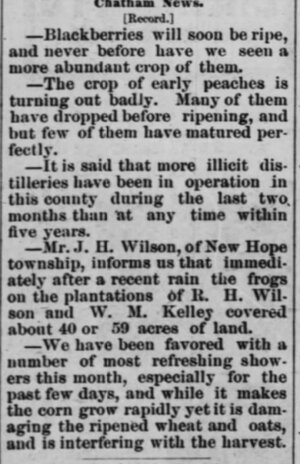
Frog Rain
And I thought it was The Devil’s Tramping Ground over in Bear Creek Township and down by Harpers Crossroads that was the only “Weird Chatham.” It seems #DeepChatham just gets deeper and deeper. Maybe the flooding over of New Hope was meant to be.
None of the liquid had fallen on her but it had drenched the ground and surrounding trees for some 60 feet (some accounts say yards) in circumference from the spot where she stood. Upon hearing her story, neighbors rushed to see for themselves and, when later interviewed, confirmed the story as related by Mrs. Lasater.
Samples were collected and sent to Dr. F. P. Venable, a professor at UNC, for evaluation. By mid-April he addressed the topic to the Mitchell Scientific Society. In every test performed except one, the conclusion was the same. The samples appeared to be blood. Venable could offer no explanation beyond the results of the tests, suggesting that “the subject is quite a puzzle and offers a tempting field for the theorist blessed with a vivid imagination.”
Chatham County “Blood Shower”
A month later the reprint from The Pittsboro Record, posted as first the comment, appeared in Orange County Observer. Of course I’m intrigued by the information that is recounted there that I had never before read - most specifically the reference to “the bars near her cabin” in the newspaper account. New Hope Township, where Mrs. Lasater (her first name goes unmentioned) lived is the part of Chatham most inundated by the creation of Jordan Lake in the 1970s and by my judgment one of the wilder parts, rivaled only by the flat woods on the far other end of the county.

The time was just post-Reconstruction, and the governor Thomas Jarvis was a Democrat, as was always the case in those days. An ex-Confederate, he was a Redeemer (Conservative, White Supremacists who worked to thwart post-Civil War Republican and African American power) and closely tied to Zebulon Vance. Indeed, he took over the office of governor when Vance went to the U.S. Senate and later filled his seat when he died in that office. In the interim he served as ambassador to Brazil.
Of course these are just musings about the tenor of the times - a particular time long past - the kind of thing my students and I try and work out as exercises in “doing history.” I’ll add that perusing the News of Chatham during that time reveals a tumultuous and mysterious place. A news report (included) from September 12, 1884 writes of a disinterred body found petrified and another from June 13, 1883 tells of a rain of frogs covering “40 or 59 acres of land” (also posted here).

Petrified Body

Frog Rain
And I thought it was The Devil’s Tramping Ground over in Bear Creek Township and down by Harpers Crossroads that was the only “Weird Chatham.” It seems #DeepChatham just gets deeper and deeper. Maybe the flooding over of New Hope was meant to be.
Last edited:
#OTD 1945 b. William Oliver Swofford in N.Wilkesboro. A Morehead Scholar @UNC, his college band unsuccessful, he recorded ‘Good Morning Starshine’ from the musical ‘Hair’ as OLIVER & hit #3 on the Billboard Easy Listening Charts in ‘69. Two months later, ‘Jean’ hit #2. He had modest success in the ‘70s, left music, had a good career in sales, & passed away in 2000. Brother John was Commissioner of the Atlantic Coast Conference & Quarterbacked @UNC. Another brother played football @dook.
Oliver, North Wilkesboro Native, a Sixties Pop Sensation
Two Morehead Scholars and one d00kie from the same family and small town.
donbosco
Inconceivable Member
- Messages
- 3,372
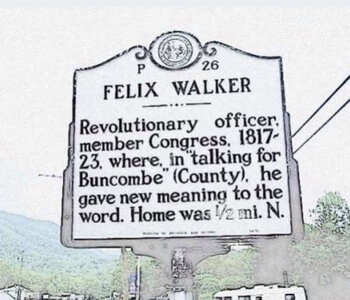
#OTD in 1820 in the US House Of Representatives, NC Congressman Felix Walker ‘spoke for Buncombe,’ #AVL #WNC. His speech was nonsense & rambling but he refused to yield the floor though beseeched. He also interrupted the important, though ultimately futile, work of framing “The Missouri Compromise.” His colleagues came to call this ‘Bunkum’ or ‘Bunk’ & a new term for worthless bloviation was born.
- Messages
- 1,102
Never knew. Pretty cool.
#OTD in 1820 in the US House Of Representatives, NC Congressman Felix Walker ‘spoke for Buncombe,’ #AVL #WNC. His speech was nonsense & rambling but he refused to yield the floor though beseeched. He also interrupted the important, though ultimately futile, work of framing “The Missouri Compromise.” His colleagues came to call this ‘Bunkum’ or ‘Bunk’ & a new term for worthless bloviation was born.
- Messages
- 1,102
Not much to choose from today. Feeling a bit meh this morning so I'll go with this. [I'll leave one for @nashcounty to post in the music thread.]
Note: I have never minded paying taxes. Part of being a contributing member of society. Nitpick all you want. We can see what happens when not enough income comes in to fund necessities such as Infrastructure not just falling apart but dangerous. See bridges.

 infrastructurereportcard.org
infrastructurereportcard.org
Sixteenth Amendment, amendment (1913) to the Constitution of the United States permitting a federal income tax.
Article I, Section 8, of the Constitution empowers Congress to “lay and collect Taxes, Duties, Imposts and Excises, to pay the Debts and provide for the common Defence and general Welfare of the United States; but all Duties, Imposts and Excises shall be uniform throughout the United States.” Article I, Section 9, further states that “No Capitation, or other direct, Tax shall be laid, unless in Proportion to the Census or Enumeration herein before directed to be taken.”
Although income taxes levied in support of the American Civil War (1861–65) were generally tolerated, subsequent attempts by Congress to impose taxes on income were met with significant opposition. In 1895, in Pollock v. Farmers’ Loan and Trust Company, the U.S. Supreme Court declared the federal income tax unconstitutional in striking down portions of the Wilson-Gorman Tariff Act of 1894 that imposed a direct tax on the incomes of American citizens and corporations. It thusly made any direct tax subject to the rules articulated in Article I, Section 2.
Consequently, unless the U.S. Congress expected all income taxes to be apportioned among the states according to their populations, the power to levy income taxes was rendered impotent. The Sixteenth Amendment was introduced in 1909 to remedy this problem. By specifically affixing the language, “from whatever source derived,” it removes the “direct tax dilemma” related to Article I, Section 8, and authorizes Congress to lay and collect income tax without regard to the rules of Article I, Section 9, regarding census and enumeration. It was ratified in 1913.
The full text of the Amendment is:
The Congress shall have power to lay and collect taxes on incomes, from whatever source derived, without apportionment among the several States, and without regard to any census or enumeration.
Note: I have never minded paying taxes. Part of being a contributing member of society. Nitpick all you want. We can see what happens when not enough income comes in to fund necessities such as Infrastructure not just falling apart but dangerous. See bridges.

Bridges
Every day, millions of trips are taken across structurally deficient bridges causing the need for updates to our bridge infrastructure maintenance program.
Sixteenth Amendment, amendment (1913) to the Constitution of the United States permitting a federal income tax.
Article I, Section 8, of the Constitution empowers Congress to “lay and collect Taxes, Duties, Imposts and Excises, to pay the Debts and provide for the common Defence and general Welfare of the United States; but all Duties, Imposts and Excises shall be uniform throughout the United States.” Article I, Section 9, further states that “No Capitation, or other direct, Tax shall be laid, unless in Proportion to the Census or Enumeration herein before directed to be taken.”
Although income taxes levied in support of the American Civil War (1861–65) were generally tolerated, subsequent attempts by Congress to impose taxes on income were met with significant opposition. In 1895, in Pollock v. Farmers’ Loan and Trust Company, the U.S. Supreme Court declared the federal income tax unconstitutional in striking down portions of the Wilson-Gorman Tariff Act of 1894 that imposed a direct tax on the incomes of American citizens and corporations. It thusly made any direct tax subject to the rules articulated in Article I, Section 2.
Consequently, unless the U.S. Congress expected all income taxes to be apportioned among the states according to their populations, the power to levy income taxes was rendered impotent. The Sixteenth Amendment was introduced in 1909 to remedy this problem. By specifically affixing the language, “from whatever source derived,” it removes the “direct tax dilemma” related to Article I, Section 8, and authorizes Congress to lay and collect income tax without regard to the rules of Article I, Section 9, regarding census and enumeration. It was ratified in 1913.
The full text of the Amendment is:
The Congress shall have power to lay and collect taxes on incomes, from whatever source derived, without apportionment among the several States, and without regard to any census or enumeration.
donbosco
Inconceivable Member
- Messages
- 3,372
IN GRAHAM

 www.dncr.nc.gov
www.dncr.nc.gov

Lynching of Wyatt Outlaw and the Kirk-Holden War
On February 26, 1870, Graham town commissioner Wyatt Outlaw, an African American, was lynched by a band of Ku Klux Klansmen.Outlaw served in the 2nd Regiment United States Colored Cavalry during the Civil War. In 1866, he attended the second freedmen’s convention in Raleigh and soon after...
Share:

